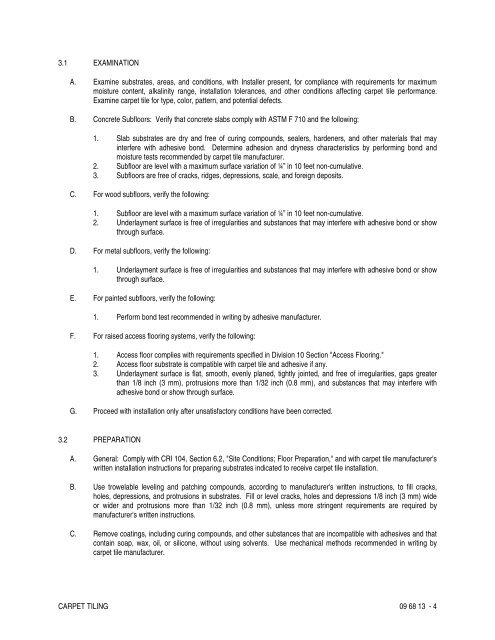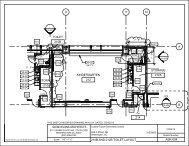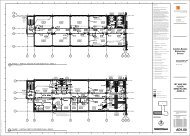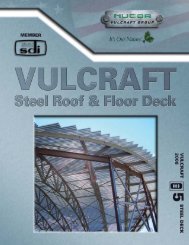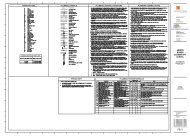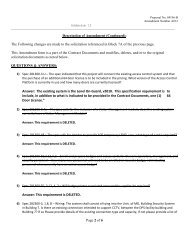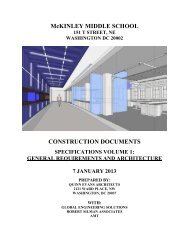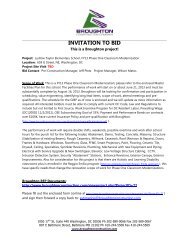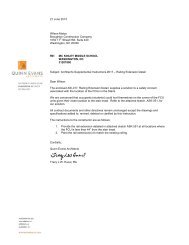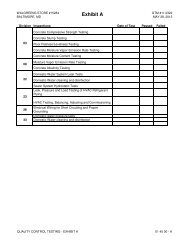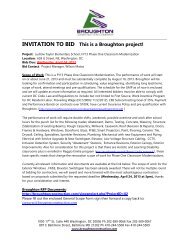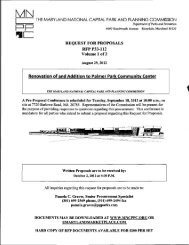DSLBD Office Fit Out - Broughton Construction Company
DSLBD Office Fit Out - Broughton Construction Company
DSLBD Office Fit Out - Broughton Construction Company
Create successful ePaper yourself
Turn your PDF publications into a flip-book with our unique Google optimized e-Paper software.
3.1 EXAMINATION<br />
A. Examine substrates, areas, and conditions, with Installer present, for compliance with requirements for maximum<br />
moisture content, alkalinity range, installation tolerances, and other conditions affecting carpet tile performance.<br />
Examine carpet tile for type, color, pattern, and potential defects.<br />
B. Concrete Subfloors: Verify that concrete slabs comply with ASTM F 710 and the following:<br />
1. Slab substrates are dry and free of curing compounds, sealers, hardeners, and other materials that may<br />
interfere with adhesive bond. Determine adhesion and dryness characteristics by performing bond and<br />
moisture tests recommended by carpet tile manufacturer.<br />
2. Subfloor are level with a maximum surface variation of ¼” in 10 feet non-cumulative.<br />
3. Subfloors are free of cracks, ridges, depressions, scale, and foreign deposits.<br />
C. For wood subfloors, verify the following:<br />
1. Subfloor are level with a maximum surface variation of ¼” in 10 feet non-cumulative.<br />
2. Underlayment surface is free of irregularities and substances that may interfere with adhesive bond or show<br />
through surface.<br />
D. For metal subfloors, verify the following:<br />
1. Underlayment surface is free of irregularities and substances that may interfere with adhesive bond or show<br />
through surface.<br />
E. For painted subfloors, verify the following:<br />
1. Perform bond test recommended in writing by adhesive manufacturer.<br />
F. For raised access flooring systems, verify the following:<br />
1. Access floor complies with requirements specified in Division 10 Section "Access Flooring."<br />
2. Access floor substrate is compatible with carpet tile and adhesive if any.<br />
3. Underlayment surface is flat, smooth, evenly planed, tightly jointed, and free of irregularities, gaps greater<br />
than 1/8 inch (3 mm), protrusions more than 1/32 inch (0.8 mm), and substances that may interfere with<br />
adhesive bond or show through surface.<br />
G. Proceed with installation only after unsatisfactory conditions have been corrected.<br />
3.2 PREPARATION<br />
A. General: Comply with CRI 104, Section 6.2, "Site Conditions; Floor Preparation," and with carpet tile manufacturer's<br />
written installation instructions for preparing substrates indicated to receive carpet tile installation.<br />
B. Use trowelable leveling and patching compounds, according to manufacturer's written instructions, to fill cracks,<br />
holes, depressions, and protrusions in substrates. Fill or level cracks, holes and depressions 1/8 inch (3 mm) wide<br />
or wider and protrusions more than 1/32 inch (0.8 mm), unless more stringent requirements are required by<br />
manufacturer's written instructions.<br />
C. Remove coatings, including curing compounds, and other substances that are incompatible with adhesives and that<br />
contain soap, wax, oil, or silicone, without using solvents. Use mechanical methods recommended in writing by<br />
carpet tile manufacturer.<br />
CARPET TILING 09 68 13 - 4


